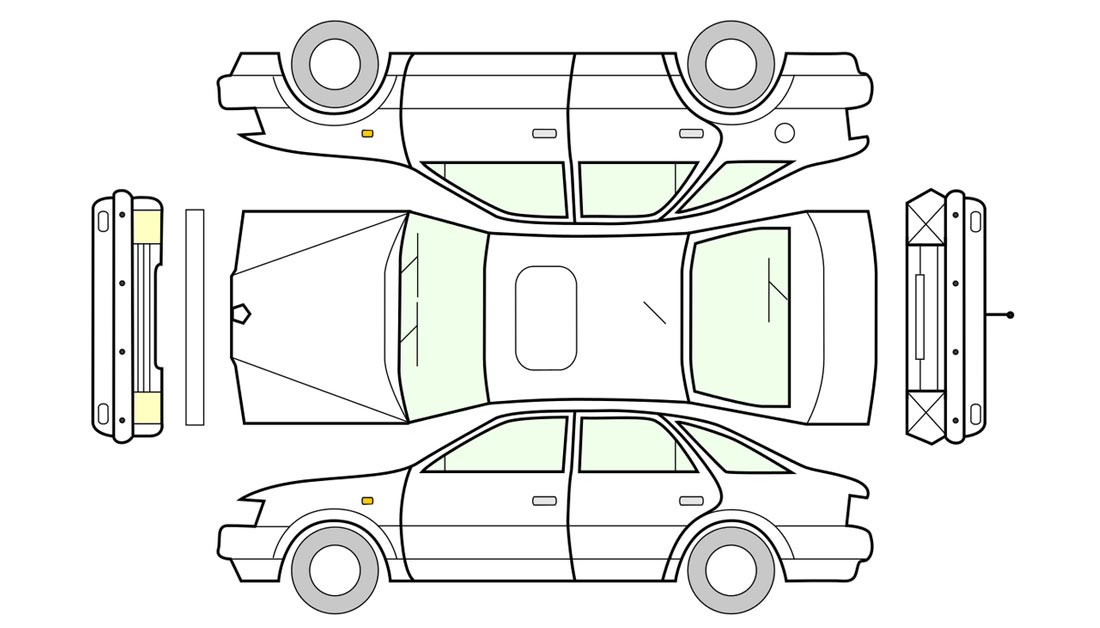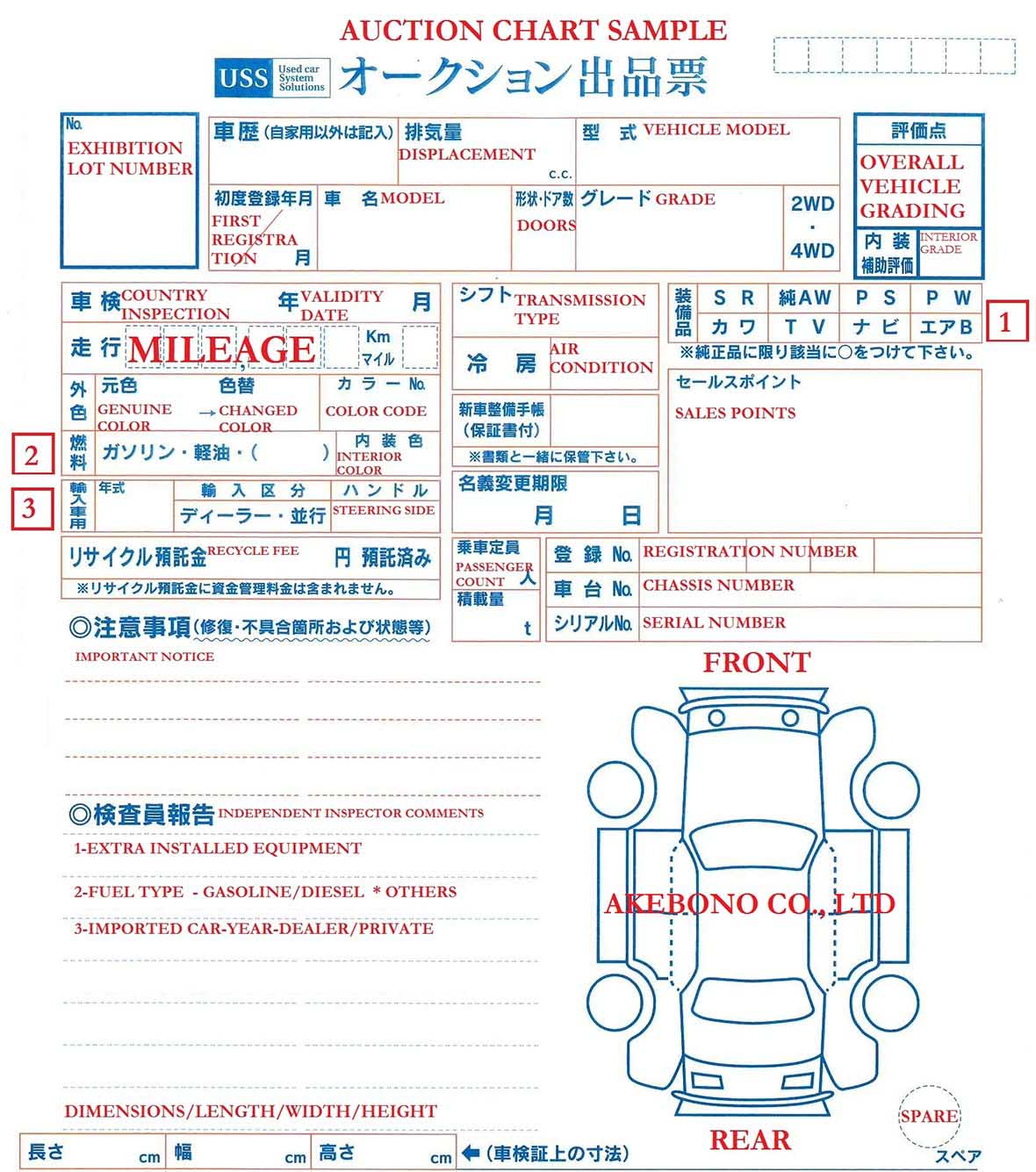Terminology

HOW TO READ JAPANESE AUCTION SHEETS?
The essential part of buying a quality car from Japan is the correct reading and comprehension of the vehicle's auction sheet. Auction sheet itself is a detailed chart that comprises main characteristics of the vehicle, exterior, interior condition and mechanical issues if there are any. All vehicles offered at auto-auctions have independent inspector’s report with comments. This is the most important stage in selecting the right vehicle and avoiding unexpected costs due to the misunderstanding of abbreviations. Before selecting a vehicle of your choice, please kindly study the structure of the auction sheet and location of the main indicators and signs. Japanese auction sheets contain the following information:
- Exhibition lot number
- Auction grading of the car
- Chassis number
- Engine capacity
- Car registration year and month
- Current mileage
- Body-colour and colour code
- Fuel type [Gasoline, diesel, CNG, PNG, LPG]
- Local dealers’ vehicle or privately imported car
- Transmission type
- Equipped options
- Model code
- Sales points
- Number of passengers [ based on the documents]
- Type of air condition
- Vehicle dimension [Width/Length/Height]
- Inspectors independent report
- Payload capacity [truck, pick up, van ]
- The previous type of ownership [ private, rental, business ]
- Tire condition

AUCTION GRADING ABBREVIATIONS AND EXPLANATIONS
OVERALL EXTERIOR GRADE
GRADE S - The car is on sale within 12 months from the first registration date. Mileage is less than 10,000km. Condition is excellent.
GRADE 6 - The vehicle is within 36 months period from the first registration date and has maximum 30.000 km mileage. Almost brand new condition.
GRADE 5 - The vehicle has some minor scratches and tiny dents. Maximum mileage is 50.000 km. Exterior and interior are in a very neat condition.
GRADE 4.5 - The vehicle`s mileage does not excess 100.000 km. Exterior and interior condition do not require any extra maintenance or cleaning.
GRADE 4 - Vehicle with a maximum mileage of 150,000km. The exterior might have some scratches and tiny dents. Interior is usually clean, but some of the cars might need cleaning and fixing of small torn areas or cigarette burn marks. In general, the vehicle might need minor repair.
GRADE 3.5 - This grade is an average condition car, with noticeable scratches and dents. It might require later panel work or painting. It may have some stains inside, cigarette burn holes, or require some repair.
GRADE 3 - This grade requires a very careful look, usually, it has many visible scratches, paint blemishes, and/or large dents. It requires major panel and/or paintwork. Interior might have multiple stains or cigarette wholes.
GRADE 2 - Very bad condition, major dents and scratches, chassis or core support have severe rust, corrosion or wholes.
GRADE 1 - Accident cars, salvage vehicles. Cars that need complete fixing or have major technical problems.
GRADES R/RA/0 - These grades depend on the auction house own grading system, please contact us for clarification. In general, R stands for repair, the exterior is in an average condition after repair had been done.
GRADE ***/-/0/無効 - These cars displayed as they are, NOT inspected cars, sold as they are.
GRADE 0 - Depending on the auction hall, grade 0 might be a fixed car or not graded car, please contact us for clarification.
-
EXTERIOR INDICATORS
AW - alloy wheels
CP - wheel covers
Aero - aero parts
3D/5D - doors
HR - High roof
HID - High-intensity discharge lamps
RS - Rear spoiler
-
SCRATCH SIGNS
A1 - Thumb size, hardly visible
A2 - Palm size scratch on the paint
А4 - Scratches more than 20 см
А5 - Scratches that need to be painted
-
DENTS
B1/B2/B3 - a dent with a scratch
E1 - barely visible dent
E2 - few dents, barely visible
E3 - many visible dents
U1 - pin dents
U2 - a visible dent
U3 - 2 a palm-size dent
-
TORN AREAS SIGNS
Y1 - A tear which is the size of a thumb.
Y2 - A tear which is the size of a palm.
Y3 - A tear which is more than size Y2.
-
RUST
S1, S2, S3 - Rust from small to sever
C1, C2, C3 - Corrosion from small to severe with a whole (sign 穴)
-
WAVY AREAS SIGNS
W1 - A panel which has been repaired slightly, and is in good condition.
W2 - A panel which has been repaired slightly, and has a slight wave.
W3 - A panel which has been repaired and has a conspicuous wave.
P or H - Paint faded
-
REPLACEMENT SIGNS
X - A panel which needs to be replaced.
! - Tender / Lease auctions use this sign for replaced parts.
XX - A panel which has been replaced.
-
CRACK
X1/ H1/G - small stone chip on the front window up 1 to cm
R - a crack on the front glass, stone chip/crack has been fixed
RX - crack on the front glass, needs replacement
-
INTERIOR GRADES
GRADE A - a very clean condition without stains, may have burnt areas or scratches
GRADE B - clean condition, the previous owner took good care of the interior
GRADE C - Interior needs some cleaning, may have small stains or cigarette burnt holes
GRADE D - The interior is not clean, must be cleaned or restored, may have some holes or cut areas
GRADE E – This grade needs complete interior restoration
-
INTERIOR indicators
PS – Power steering
PW – Power window
AAC /AC/ – Automatic or non-automatic air conditioning
AB, SRS, WAB – Airbag types
AT, FA, FAT, IAT, CA, CAT, CVT, ICVT - Automatic transmissions
MT, F5, 5C, 5SPD/6F/6 – Manual transmission
NAVI, GPS – Navigation system
ST/CD / MD /TV - Music and video equipment
革, レザー, カワ, LS – Leather seats
SR, サンルーフ – Sunroof
-
TECHNICAL DESCRIPTION
LPG, CNG, LNG – Gas fuel types
ABS – Anti-lock braking system
AFS – Adaptive Front light System
LSD - Limited slip differential
EVC – Electric Vehicle Car
TRC, TCS - Traction Control System (TRC)
2WD/4WD – Drivetrain type, two/four-wheel drive
-
SPECIAL INDICATORS
$ or *,# - these signs represent the changed mileage, tempered odometer or odometer change
改 - ( kai mark ) – This sign represents modification done by previous owners, for example:
Performance cars
- Additional horsepower, multiple aftermarket parts, extra equipment and engine modifications
- After-market suspension, seats, steering wheel etc.
- Mission modification, the original AT mission converted to a manual transmission.
Passenger cars, Vans, Trucks
- The previous owner has converted fuel from gasoline to LPG or CNG gas
- Removal of seats and instalment of special purpose equipment such as ambulance or camping car.
-
JAPANESE 平成 CALENDAR CONVERSION
In Japan, the registration year is indicated on all documents, NOT the actual Manufacture date /MFDT/. Please pay attention, the registration date might differ from actual Manufacture /MFDT/ date on the belt. Japanese year calculation— 2018 is the year 30 of the Heisei (平成) era, from 8 January 1989 to the present. Please pay attention to the registration and actual manufacture date when calculating your import tariffs and local registration fees.
